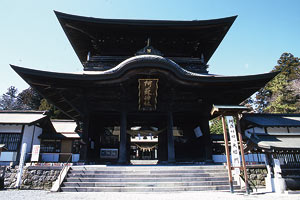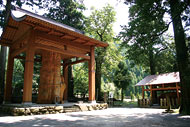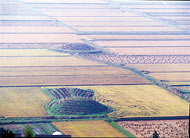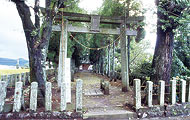11.The Deity of the Volcano Geosite

Exploring the roots of the culture centered on Aso Volcano
This geosite includes Aso Shrine, located in the Ichinomiyamachi district of Aso City, as well as Kokuzo Shrine and the Nakadori Ancient Tombs, where members of the Aso family are said to be entombed. Twelve deities are enshrined in Aso Shrine, principal among them the pioneer god of Aso, Takeiwatatsunomikoto, who is worshipped in the main shrine building. The traditional agricultural rites practiced at the shrine are designated as a national Important Intangible Folk Culture Asset. Many of the points of interest at this geosite are deeply connected to the myths of the Aso region. For instance, Shimomiya Shrine enshrines Kihachi, a retainer of Takeiwatatsunomikoto whom according to legend was slain by the god.
Aso Shrine
Aso Shrine has over 500 sub-shrines throughout Japan. Six of its structures are designated national Important Culture Properties: Ichinoshinden, Ninoshinden, Sannoshinden, Roumon, Miyukimon, and Kangyomon. The main shrine building is in the distinctive "Aso style" of unpainted keyaki, and the Roumon is one of Japan's three most famous two-story shrine gates, measuring 21 m high. Along with the main shrine gate, it is covered in fine carvings and is notable not only for its size but for its beauty. Aso Sanjo Shrine, a branch of Aso Shrine, is located in a clearing on top of Mt. Aso, next to the Mt. Aso ropeway.

Kokuzo Shrine
Built in the 18th year of Emperor Sujin's reign (approx. 1st century BC), Kokuzo Shrine sits approximately 6 km north of Aso Shrine, and is also referred to as "the north shrine." Four deities are enshrined here, principal among them Hayamikatamanomikoto, first son of Takeiwatatsunomikoto, Aso's pioneer god. As at Aso Shrine, the agricultural rites performed here are a nationally designated Intangible Folk Cultural Asset, and the front and main shrine buildings are designated municipal Tangible Cultural Assets. The Teno-no-osugi Japanese cedar that grows within the precincts was formerly a national natural monument. Measuring 11 m around the trunk and 48 m high, this majestic tree has witnessed over 1,300 years of Aso's history. However, on September 27, 1991, a typhoon severed the trunk about 11 m above the ground.

Nakadori Burial Mounds
Aso's foremost group of ancient burial mounds stands at the confluence of the Kurokawa River and its tributary the Higashidake river, amid the rice fields of Asodani Valley's northeastern region. Visitors can observe twelve mounds, including some built in the "keyhole-shaped tumulus" style that dates to the early to mid 5th century.

Kaminokokura and Shimonokokura Burial Mounds
These ancient burial mounds adjoin Kokuzo Shrine in the Ichinomiya district. The Kaminokokura mound measures approximately 33 m across and 5.3 m tall, while Shimonokokura is slightly smaller at 30 m wide and 4.5 m tall. Both are round, have stone burial chambers, and are believed to hold the remains of members of powerful clans.

Shimomiya Shrine (Frost Shrine)
Among the deities worshipped at this shrine are the god of the heavens, the god of the Big Dipper, and the frost god. To ward off the threat of frost to crops, young girls traditionally guard the flames in the fire sanctuary for 59 days, from August 19 to October 18 each year. The ceremony is called Hitaki no Shinji, and is a nationally designated Important Intangible Folk Culture Asset.
